For many people in British Columbia, going camping is one of the essential hallmarks of the summer season.
But it also is a source of stress, with popular campgrounds being booked months in advance.
In this post, I’m going to share the techniques I’ve been using to successfully (and repeatedly) go camping in BC without a reservation. This includes provincial park camping as well as other locations.
So if you’ve been unlucky not to secure a BC Parks camping reservation or simply just don’t want the stress of even trying, this post is for you!

Disclaimer
Some of these tips and techniques will not be applicable for everyone. As a self employed person without children, I recognise that I have more flexibility than a lot of people.
Despite this, I still believe that most campers will be able to find something helpful in the following article.
This post includes affiliate links. If you make a purchase via one of these links, we may receive a small percentage at no extra cost to you.
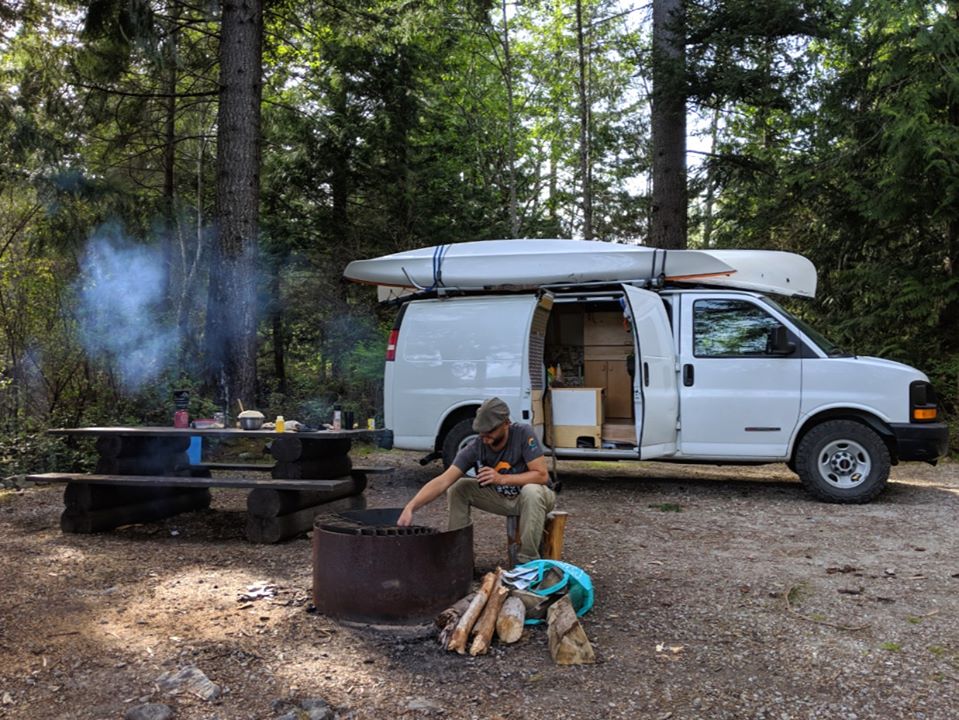
Camping necessities
- Always bring the 10 Essentials
- Know how to stay safe
- Remember to Leave No Trace to help keep the wilderness wild
- Understand how to avoid negative bear encounters
- Recommended gear is listed on our Shop page
- Need a packing list? Sign up to our newsletter for a free one!
Securing a provincial park campsite without a reservation
Provincial park campgrounds are a favourite camping destination for British Columbia residents as well as visitors. It’s easy to understand why.
BC’s provincial park campgrounds are usually set in beautiful and convenient locations and feature large, private campsites surrounded by nature.
Sites are usually reasonably priced too, averaging at a fixed price of around $20-$30/night.
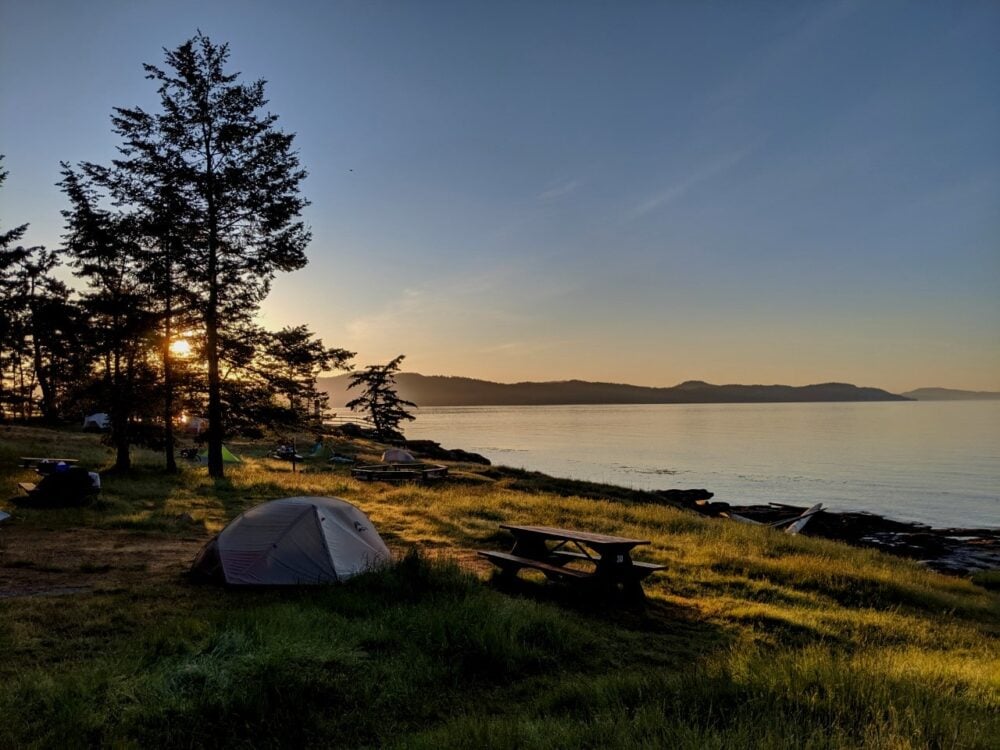
But securing a provincial park camping reservation can be tough.
The competition for spots in some parks is very high, with reservations for summer weekends in campgrounds like Rathtrevor and Miracle Beach being snapped up within minutes.
Read on for my top tips on how to secure a campsite in a BC Parks’ campground without a reservation.
Locate campgrounds with first come first serve campsites
Not all campsites in frontcountry BC Provincial Park campgrounds are reservable.
About 45% of all individual campsites are actually available on a first come first serve system (FCFS).
Some campgrounds have just a dozen or so FCFS sites. Others do not allow reservations at all.
Some examples of campgrounds with substantial numbers of FCFS campsites are:
- Pyramid Campground, Wells Gray Provincial Park
- Englishman River Falls Campground
- Quinsam Campground, Elk Falls
- Silver Beach Campground
- Champion Lakes Campground
- Coldspring and Mule Deer Campgrounds, E.C. Manning Park
- Kitty Coleman Campground
- Lac La Hache Campground
Check out time for provincial campsites is 11am. By that time, FCFS campsite occupants have to have paid for another night or vacated.
If the latter, the site is now available to be claimed OR allocated as per the Park Facility Operator’s daily wait list. At the campground I worked at, the wait list was started at 7am each day.

Consider a double site
Double sites at provincial parks (designed to allow two camping parties to camp in close proximity) must be reserved together and are usually sold last.
If not reserved together, each half of the double site becomes available to book a week before the selected arrival date.
The double sites at the campground I worked at were even sometimes available on holiday weekends due to lack of interest.
Always check for cancellations
Campground availability may change more than you think. I would recommend checking Discover Camping regularly to see whether any bookings have been cancelled.
If you don’t want to check for cancellations yourself, Campnab can do the work for you. They will send you a notification when a site is available.
And even if provincial campgrounds appear to be completely booked, it’s still worth checking in person for no shows.
Reserved sites are held until 11 AM the day after the scheduled arrival date. So if someone doesn’t notify the campground host of a late arrival, their entire reservation will automatically be cancelled the next day.
While working at provincial park campground, I was always surprised by the amount of people who would book a long stay (up to two weeks) and then leave early.

Bring a tent
Alongside double sites, walk-in sites are often the last ones to be sold. A walk-in site can only be used by a camping party with tents, since there is no driveway access.
This means that anyone sleeping in a vehicle (such as an RV or van) cannot use the site.
Walk-in sites do not feature in every BC Parks provincial campground.
If you’re interested in camping at a park that does have these type of sites, be sure to bring a tent along. Campers who have the flexibility to use walk-ins are more likely to be able to score a last minute campsite.
Don’t hesitate
If there are only a few sites available on arrival at a provincial campground, be sure to claim one quickly.
Hesitation may cost you the possibility of having a camping site at the more popular campgrounds. Of course, you an usually move to a different site later if necessary.
I couldn’t tell you the amount of times I had prospective campers tell me they wanted to look around and ended up spending over an hour choosing between sites before committing.
By the time they made their final decision, there would be no sites left. It is a much better idea to get a site allocated to you first and then shop around.
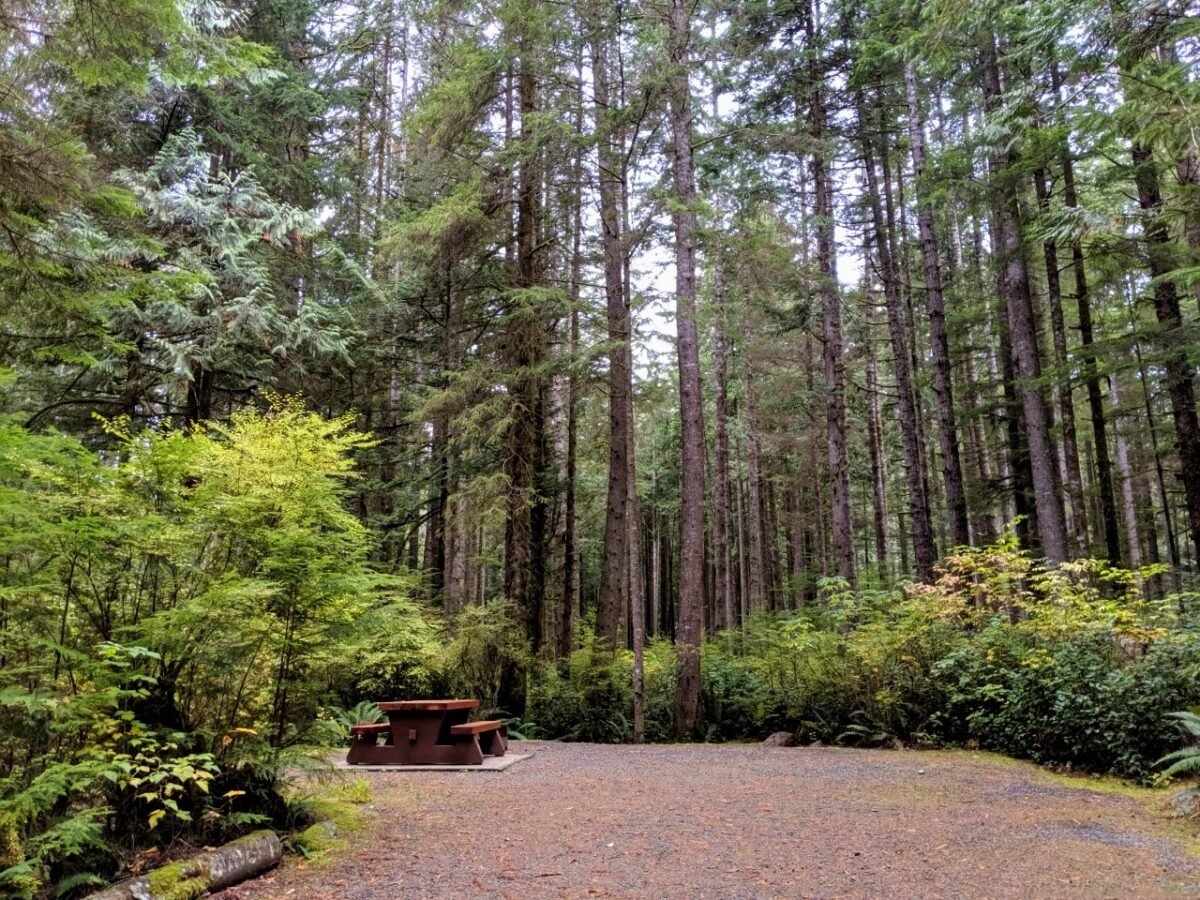
Camp in September
I know, I know, it’s not summer but September can offer some truly lovely weather in British Columbia.
Not only that, but all frontcountry provincial campgrounds start operating on a first come, first serve system after the Labour Day holiday in September.
Of course, it is important to also note operating dates as some campgrounds close after the first or second week of September.
Head into the backcountry
If you have the skills and equipment, consider going on a camping trip in the backcountry.
Only a few backcountry camping areas within BC’s provincial park system require reservations – they are Garibaldi, Joffre, Assiniboine, Buckhorn (Manning Park), Kicking Horse (Manning Park) Frosty Creek (Manning Park), Bowron Lakes and Mount Robson.
Most backcountry campsites in BC’s national parks require a reservation.
All other backcountry campgrounds operate on a first-come, first-serve basis.
For trip inspiration, head to our reservation-free BC backpacking guide.

When venturing into BC Parks’ backcountry areas, be sure to –
- Bring the 10 essentials and know how to use them
- Pack out everything you packed in
- When not using an established campground, camp on durable surfaces only
- Allow plenty of time to reach your desired camping area
- Leave everything you find except trash (if you can, pick that up and dispose at home)
- Store food, food containers and scented items securely to avoid attracting wildlife
Purchase a BC Parks Backcountry Permit permit online or use the self-serve registration facilities at designated trailheads and access points. Note that paying for a Backcountry Permit does not guarantee a camping spot.
If you’re thinking of getting into backpacking, read my Backpacking 101 Guide, gear up and then choose an easy overnight hike to get started.
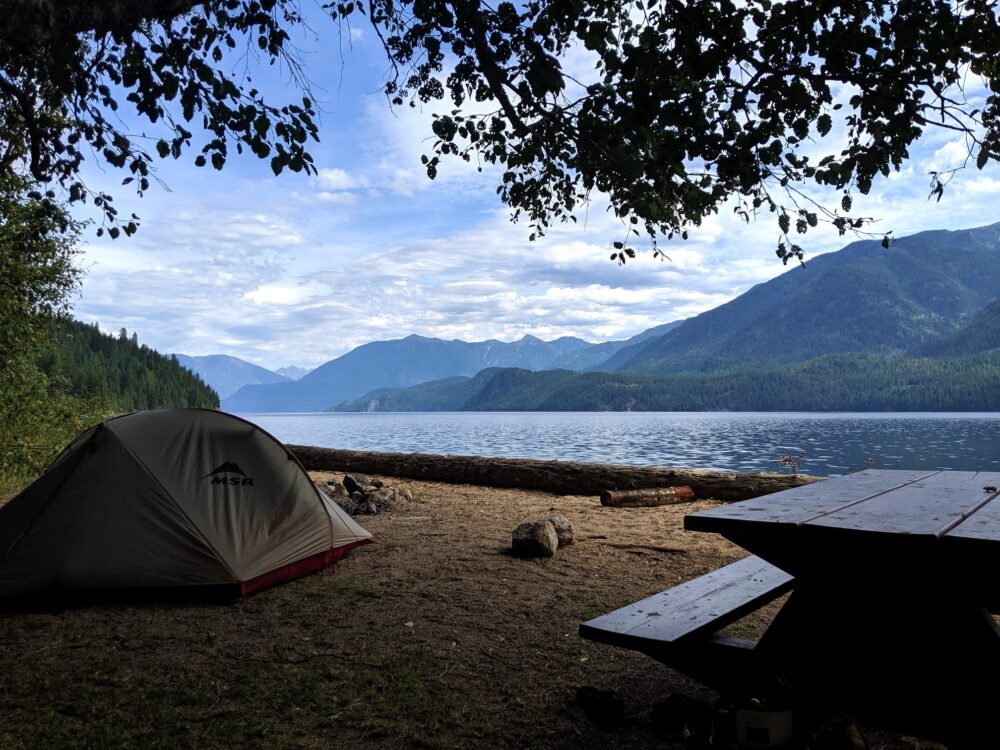
Other places to go camping in British Columbia without a reservation
While provincial park campgrounds are wonderful, there are other places to go camping in British Columbia.
Recreation Sites
There are hundreds (in fact, probably thousands) of free or low-cost campsites located around British Columbia in the form of rustic Recreation Sites.
Working on a first-come, first serve system, Recreation Sites are my top recommendation for anyone who doesn’t want to (or didn’t manage to) make a campground reservation.
Click to read more about Recreation Sites and how to find them across British Columbia
One of the most important things to keep in mind regarding Rec Sites is that they are typically reached via gravel roads, primarily built for industrial use (logging, mining etc). If you don’t have a suitable vehicle of your own, you’ll need to rent one that can be driven on such roads.
FarOut Wilderness offer fully kitted out 4X4 trucks with roof-top tents, ideal for finding reservation-free campsites in BC. They also rent roof-top tents to use on your own vehicle. Enjoy a 5% booking discount if you tell them I sent you (with the code FOW-OTT-5)
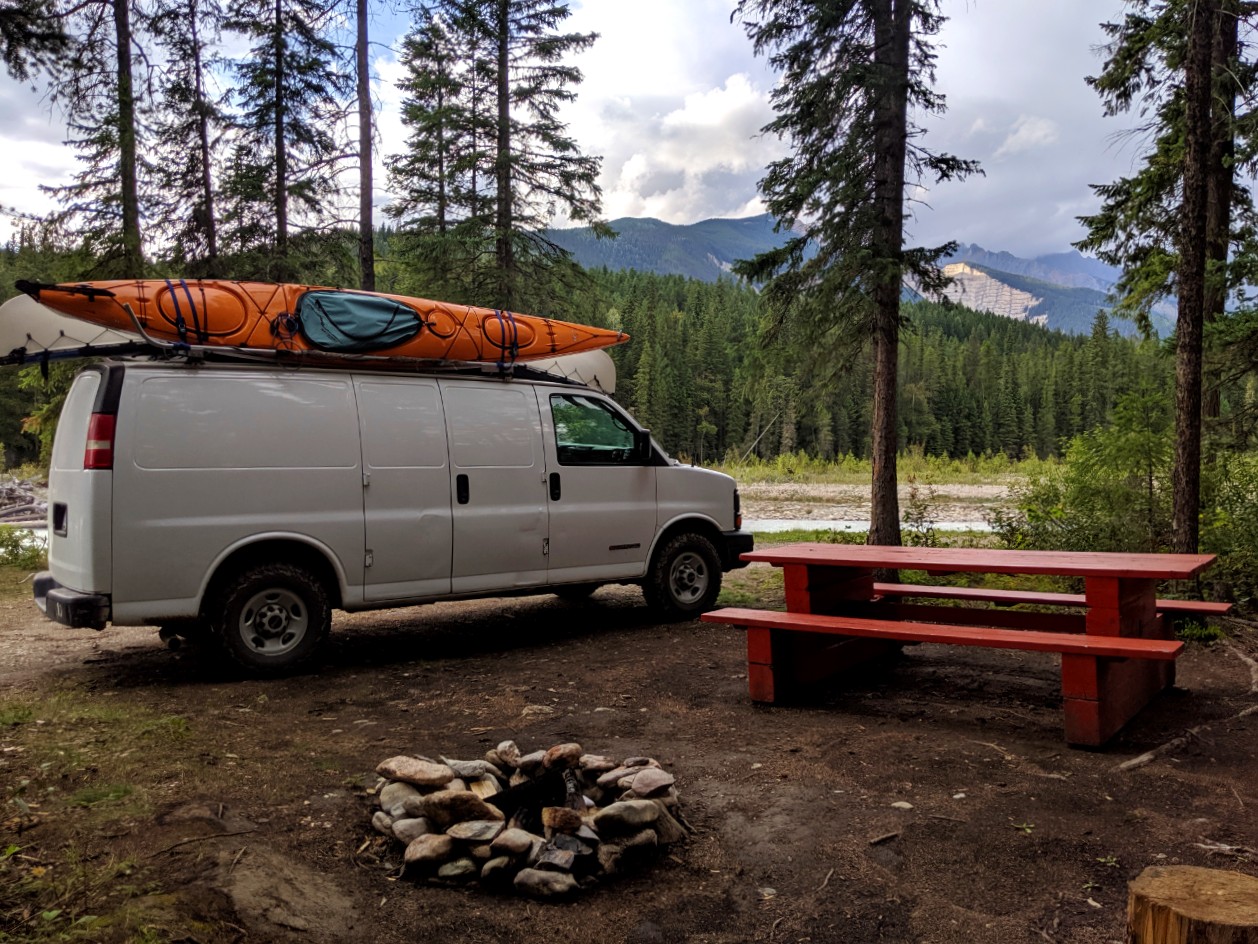
Crown land
About 94% of British Columbia is designated as ‘Crown Land’ which is available to Canadians for public use.
Backroad Mapbooks are a good place to start when trying to locate crown land for camping purposes (and especially when travelling), followed by iMapBC (or ParcelMap) for more in depth research.
Camping on crown land has a 14 day maximum in any one place. It is absolutely crucial to be considerate of other crown land users as well as local residents and wildlife.
This means making sure that you follow Leave No Trace Principles.
- No toilet in your vehicle? Use the cathole method for proper waste disposal
- Pack out everything you bring in with you, including ‘natural’ items like banana peels and apple cores
- Camp on durable surfaces only, preferably areas that have already been used for camping
- Build campfires in existing fire rings, keep fires small and extinguish them properly (or consider not having one!)
Following these simple steps ensures that the crown land remains clean, beautiful and accessible for everyone (wildlife too!)

Private, municipal and regional campgrounds
The vast majority of private and municipal campgrounds utilise reservations but there are the occasional instances of campgrounds having a small amount of first come first serve sites. The only real method for finding these exceptions is to research, research, research!
Jordan River Regional Campground on the Juan de Fuca coast on Vancouver Island is one example of a FCFS campground as is nearby Spring Salmon Place (KWL-UCHUN) Campground in Sooke Potholes Regional Park.

General tips and tricks to go camping in BC without a reservation
While keeping all of the above in mind, here are some more general tips for reservation-free camping in BC.
- Weekdays are less busy than weekends, by far. If you can take holiday or change work shifts to be able to go camping during the week, do it!
- Avoid long weekends. Yes, it may sound obvious but for the best chance of finding a campsite, do not go camping on long weekends
- August, in general, is busier than July for camping in BC. Demand starts to tail off during the last week of August in readiness for schools reopening but then returns to peak levels for the Labour Day long weekend at the start of September
- Go further. The closer a campground is to population centres, the more crowded and in demand it will be. Isolation and distance are key to finding less used campgrounds
First time camping? Check out my Camping 101 guide for top first time tips!

Essential items for camping in British Columbia
- I say it often on this site, but a lightweight tarp is a must-have when camping in BC. Great for both shade and rain, these tarps pack down conveniently small. We personally use a Rab Siltarp 2
- We swear by the Backroad Mapbook series to find camping spots across the province. Sure websites are great too but many of the places we frequent do not have phone signal. The guides are also indispensable for navigation on logging roads
- Most provincial park campgrounds have water taps with drinking water. Elsewhere, you’ll need to use some kind of purification system to make water safe to drink. Aquatabs work well for clean (not dirty) water but leave a taste. For car camping we use a Katadyn Base Camp Pro
- If cooking on the fire is important to you, consider bringing your own grill. We find that many of the firepit grills at free Recreation Sites are in varying states of disrepair. Check out TrailGourmet for some camp cooking inspiration
- Not an item, but be sure to view current campfire bans and restrictions before heading out to camp
- OK, it’s not strictly essential but why not camp in complete comfort with a two person hammock? We love our bright ENO DoubleNest
Visit our Resources page to see more recommended items for camping and outdoor adventure

Check out these other posts featuring camping in beautiful British Columbia:
25+ of the Best Vancouver Island Campgrounds
How to Reserve Backcountry Camping in BC: Essential Details and Dates
What To Do in Wells Gray Provincial Park, British Columbia
Hiking the Della Falls Trail, Vancouver Island, BC
Wallace Island: An Idyllic Kayaking Destination in British Columbia
A Complete Adventure Guide to Valhalla Provincial Park
Paddling the Bowron Lakes Canoe Circuit


One half of the Canadian/British couple behind Off Track Travel, Gemma is happiest when hiking on the trail or planning the next big travel adventure. JR and Gemma are currently based in the beautiful Okanagan Valley, British Columbia, Canada. Consider buying us a coffee if you have find any of our guides helpful!

Hello! I was hoping to get some more info from you guys about the walk in sites at the Sproat lake provincial park? Is the parking too far from the sites and would an 8 person tent fit in one site? Thanks and nice blog btw. Very helpful!
Hi Pat,
The walk from the edge of the nearest parking lot is about 200m. I don’t know if you’ve seen my photo of the sites, but you see it here. There isn’t a lot of division or spacing between the sites. The tent space, as you can hopefully see in the photo, is pretty large. I hope that helps!
Hi Gemma, Thank you so much for this helpful post! Do you mind explaining the wait list system a bit more? I’m hoping to camp at Mermaid Cove (Saltery Bay) but we want to do a long hike that same day. We’ll finish the hike around 5pm and are struggling to figure out the best strategy for getting a campsite. I’m wondering if it makes sense to drive to the campsite in the morning (i.e. before the designated check out time) and put our name on a wait list? I’m wondering how that’d work! Appreciate your help 🙂
Hi Sonia,
I’m not sure there is a standardised system for the wait list – the process mentioned in the post was just how it was done at the BC Parks campground I worked at. I do believe that the other local BC Parks campgrounds (run by the same contractor at the time) were run the same way.
We started a wait list at 7am (when I arrived for work at the campground gatehouse) and then all interested parties had to return at 11am (check-out time). At that point, we would know how many of the campers in the first come, first serve sites would be leaving. We would then allocate sites as per the arrival order on the original wait list created at 7am. If someone on the list wasn’t there in person, I would move on to the next person on the list.
Other contractors may do it differently. I assume we had this system primarily because our campground had a gatehouse with staff on duty from 7am to 11pm. Smaller campgrounds without a gatehouse may have a much more casual system.
If I were you, I would visit the campground in the morning and find the Park Facility Operator (PFO for short) and ask. Alternatively, you could directly contact the contractor now and ask – Saltery Bay is run by Wilderness Recreation Services Ltd. Keep in mind that they probably get a lot of questions like this so if they are busy, don’t take it too personally!
This has been the most organized and informative post that i have read so far. And i’ve been reading ALOT! Thank you.
Awesome, thank you Judy!
Thank you! What a great post. I am a Vancouver Islander, and this information is priceless for visitors here. I spent years finding free camping in my little van all over the island — particularly in the off-season — but these tips and informative thoughts are going to help a lot of people.
I hope you’re still active!
Hi Michael,
I’m glad you enjoyed this post! We publish 2-4 posts every month on the website and also have a Facebook page.